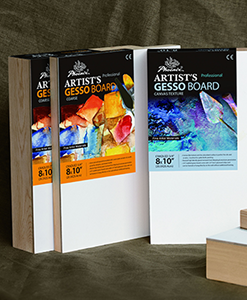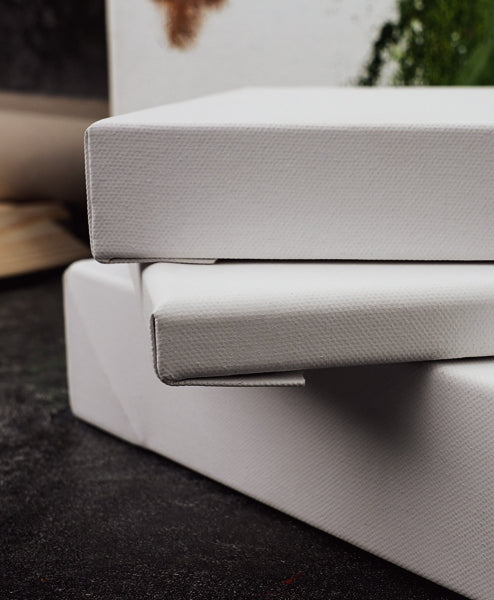Preparing Paint Boards: A Deep Dive for Serious Artists
In the world of fine art, where every layer counts toward lasting impact, readying a paint board becomes a deliberate act of foresight. This isn't about quick setups for casual sketches—it's about crafting rigid foundations that anchor your pigments through time, drawing on centuries of studio wisdom and modern material insights. If you're weighing "paint board vs panel" options or hunting for the "best paint board for oils," this guide unpacks the subtleties with clear visuals in mind: think cross-sections of sealed layers or side-by-side substrate tests.
We'll move from core choices to hands-on steps, always tying back to how these decisions shape your work's endurance. Rooted in conservation practices and surface dynamics, you'll learn to build boards that offer high absorbency without compromise, ensuring your glazes or bold strokes stay true for decades. Roll up your sleeves—let's start with the surface that matters most.
When Rigid Beats Flexible Every Time
Picture your painting flexing under its own weight years from now—cracks spiderwebbing through the film, colors fading unevenly. Rigid supports like paint boards sidestep that fate, holding steady where canvas might yield. From van Eyck's era to today's galleries, these unyielding bases have proven their worth, especially when longevity trumps portability.
What Sets Them Apart in Daily Use
Boards shine in setups demanding precision, like detailed oil glazes that need a non-shifting plane to build depth. They cut down on the subtle shifts that plague flexible surfaces, letting you layer without second-guessing adhesion. For mixed media, where textures collide, a board's even rigidity keeps everything aligned, avoiding the warps that undo careful compositions.
Yet they're no universal fix—heavier than stretched fabric, they suit studio walls more than field kits. Lean toward boards when your goal is archival strength, particularly in "paint board vs panel" choices: panels often wrap edges for a polished look, while boards focus on frontal priming for broad technique freedom. The payoff? Pieces that stand gallery scrutiny without constant tweaks.
Drawing from History for Modern Gains
Back in the Renaissance, artists turned to poplar boards coated in gesso for that same unyielding hold—surfaces that breathed just enough to cradle egg tempera without buckling. Today, we echo that with conservation quality builds, where boards' stability fights off humidity's pull, preserving your intent across seasons.
Starting with the Right Base Material
Your board's heart lies in its core—choose wisely, and the whole piece hums; falter, and flaws ripple through. Think of it as selecting a canvas's weave, but for solidity: substrates vary in how they grip primers and shrug off stress.
Breaking Down Common Choices
Hardboard, pressed from wood fibers, delivers a naturally level plane that's forgiving under the brush—perfect for acrylics craving quick uptake. Plywood stacks veneers for balanced give, standing tall in larger formats without the cup that plagues single slabs. MDF blends particles into uniformity, though its thirst for moisture calls for extra sealing upfront.
Aluminum composites step in for the ultralight crowd, their sleek rigidity suiting oils that demand no distractions from the stroke. Clay-infused boards nod to old masters, layering Kaolin gesso for an extremely smooth finish that drinks in watercolors yet holds firm. Each brings trade-offs: plywood's warmth versus aluminum's chill neutrality.
Matching to Your Painting Style
For the best paint board for oils, gravitate to plywood's subtle flex—it mirrors wood's natural response to drying films, easing tension as layers cure. Acrylic users might prefer hardboard's high absorbency, where pigments sink in without beading. In "paint board vs panel" terms, raw boards invite custom priming on top, while panels come edge-sealed for immediate framing.
| Base Type | Strength in Action | Drawback to Watch | Ideal Match |
|---|---|---|---|
| Hardboard | Even under pressure | Tannins if unsealed | Acrylic flows |
| Plywood | Steady in size shifts | Weight builds up | Oil builds |
| MDF | Smooth start to finish | Swells in damp | Budget layers |
| Aluminum | Featherlight hold | Needs grip aids | Travel pieces |
These picks ground your prep in real-world fit.
Layering Up for a Surface That Lasts
With your base set, the real craft unfolds in the build—each coat a barrier against time's wear. This isn't slapdash slathering; it's measured steps that tune absorbency and tooth, creating a bed for your colors to thrive.
Sealing the Foundation First
Begin by clearing the slate: a pass with alcohol wipes away factory oils, paving clean bonds. Then comes the size—a thin veil of glue or polymer that tempers the board's hunger, cutting absorbency just enough to guide your paints.
Dry it slow in steady air, checking for tack with a light touch. Rush this, and bubbles mar the calm ahead.
Building the Gesso Backbone
Stir your mix to a soft cream—chalk, binder, and white for body. Brush it broad and bold across the grain first time, letting it seep for grip. Follow with three or four more, each sanded feather-light to refine the tooth: early layers soak deep, later ones sculpt the subtle drag that catches bristles just right.
For clay boards, fold in Kaolin for that Renaissance whisper—extremely smooth, yet alive with pull. Edges get the same care, beveled soft to flow into frames without snags.
Visual Flow: Imagine the stack—raw grit giving way to primed sheen, each pass sharpening the invite for paint.
Fine-Tuning for Feel
Test the give: a finger across should meet quiet resistance, not slip or snag. Cure fully, perhaps warming gently, to lock in the hush before your first mark.
Adapting the Prep to Your Chosen Medium
No two paints play the same—oils creep slow and deep, acrylics snap sharp and fast. Tailor your board's face to match, or risk films that fight back.
Handling Oils with Care
The best paint board for oils calls for a yielding edge: oil-ground mixes in your layers, four to six thin veils that bend with the film's breath. Add stabilizers against light's fade, drawing on conservation quality tricks to keep glazes glowing true.
Quick Marks in Acrylic Territory
Here, fewer coats—two or three—keep high absorbency alive for those lively pours. Silica whispers in the gesso boost the key, letting emulsions lock without pooling, ideal for gouache's wet blends too.
Blending Worlds in Mixed Media
Plywood shines when textures tangle—neutral glues bridge gaps, while variable tooth welcomes collage without lift. Paper boards step up for gouache and acrylic holds, their rigid calm weathering bold gestures.
| Paint Type | Coats to Aim For | Surface Secret | Why It Works |
|---|---|---|---|
| Oils | Four to six | Slight flex in ground | Eases dry-time stress |
| Acrylics | Two or three | Boosted key from silica | Speeds even spread |
| Mixed | As needed | Neutral bridge layers | Binds without bite |
These shifts make your board a quiet partner.
Catching Problems Before They Spread
Even solid preps can stumble—moisture sneaks in, bonds weaken under haste. Spot these early, and your board stays true; ignore them, and the whole build unravels.
When Layers Won't Stick
Oils from the mill leave ghosts that repel gesso. Wipe again, then prime with a promoter—diluted medium that weds the worlds. Test: a drop of water should bead, then sink slow.
Cracks from Too Much Rigidity
In oils on unyielding bases, films split as they shrink. Ease it with polymer-laced coats for micro-yield, or shift to a wrapped panel for buffered edges in "paint board vs panel" setups.
Bleeds and Swells in the Core
Tannins rise from unsealed hardboard; double the size to dam them. MDF bows in damp—prime both sides even, balancing the pull.
Side Views: Flawed lift (wet gloss gone dull) beside mended evenness.
Quick Fix: Always air-dry between, watching for tells like dull sheens.
Pushing Boundaries with Custom Builds
Once the basics hum, experiment opens doors—embed meshes for quake-proof holds in public works, or profile aluminum with UV grounds for sun-kissed murals. Clay boards let you chase historical ghosts, sanding gradients to age the tooth like a master's heirloom.
In conservation, these preps heal old wounds: fillers match pH, restoring breath to faded panels. For rigid paint boards in fresh twists, composites shrug off salts, their slick calm repelling time's grit.
Guarding Your Prep Against the Years
A prepped board earns its keep through care—shelter it in even air, sleeves free of acids, at mid-humidity sweet spots. Varnish seals the story post-paint, warding dust and light. Check yearly: lift edges for hidden shifts, refresh primes if whispers of wear appear.
This routine, straight from conservation playbooks, stretches your handiwork into legacies.
Wrapping It All into Your Practice
From picking a base that bends to your will to layering a face that welcomes every stroke, preparing paint boards weaves science and instinct into something enduring. Whether chasing the best paint board for oils or sorting "paint board vs panel" paths, these steps quiet the ground for your voice to rise clear.
Dive in, adjust as your marks demand—your next layer waits on a surface built to last.










